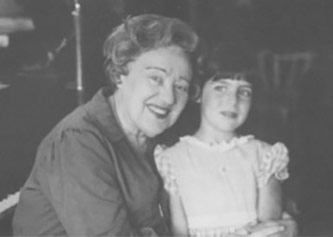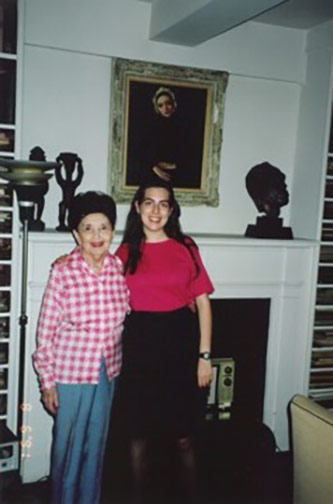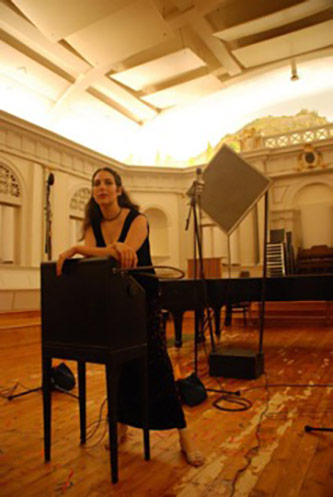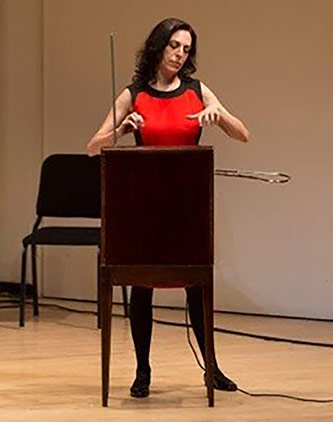American Music Review
Vol. XLVIII, Issue 2, Spring 2019
By Dalit Warshaw, Brooklyn College, CUNY, and The Juilliard School
I first met theremin virtuoso Clara Rockmore when I was a very young girl, during one of my frequent visits to her sister, the brilliant pianist Nadia Reisenberg. My relationship with Nadia was deeply unique, as she was the first significant musical role model during my development as a pianist, and the first to encourage my budding aspirations as a composer. At eight years old, I was greatly rattled by her passing in 1983 at the age of seventy-eight. Soon after, her younger sister Clara began to assume Nadia’s precious and definitive role in my burgeoning life as a creative and performing artist.

Nadia Reisenberg and Dalit Warshaw, age 7, 1982
Throughout my childhood and adolescence, Clara was family. She would attend the performances of my latest orchestral music. She was one of the few mentors for whom I would play through a program for a pending piano recital or concerto appearance, as her reactions were always exceedingly intuitive and inspirational. These occasions would typically take place in her old Art Nouveau apartment at the Parc Vendome on West 57th Street, accompanied by elaborate teas that included her sister Newta Sherman’s homemade piroshki. At other times, they would occur at my childhood home in upstate New York, where Clara always loved to visit during the last stages of autumn to see the leaves. I was eighteen years old when Clara introduced me to the inventor Leon Theremin (born Lev Termen), during his first visit to New York since his abduction by the KGB from his uptown apartment in 1938. That visit included his appearance in Steven M. Martin’s excellent documentary Theremin: An Electronic Odyssey.
When I first heard Clara play her theremin, I was immediately struck by her incomparable tone that suggested a sonic mélange of violin and voice merged with the otherworldly. My natural ability for the instrument led Clara to begin teaching me in 1991, when I was sixteen years old. Bob Moog was invited to study her theremin (custom-built for her by Theremin) so that he could build a replica for me, my Moog 91W model.
Clara Rockmore and Nadia Reisenberg play Achron’s Hebrew Melody
I will always remember Clara best as she was in those years: though in her eighties she was luminous and immortal, ever stunning, jet black hair always beautifully coiffed, lips painted a vivid red. She kept her nails consistently bright red as well, to enhance the dramatic effect of her aerial fingering, or “witchcraft,” as she amusedly called it.
The theremin itself is one big paradox. It is an electronic instrument, yet can sound profoundly musical, even human. It is the one instrument which, though electronic, is completely controlled by the person manipulating it. Invented in Russia in 1919 (and also known as the “Termenvox,” ethervox, or etherwave), its wiring includes two radio frequency oscillators, controlled by two metal antennas that respond to the position of the player’s hands: one antenna for frequency (or pitch), the other for amplitude (or volume). While it is the forerunner of so many subsequent technological inventions, from high security alarm systems to the synthesizer, it also remains the electronic instrument most sensitive to human presence, despite the fact that it is played without being touched. Engaging with the theremin is all about controlling the uncontrollable, as the performer is essentially disciplining air. A master performer possesses the capacity to transform an odd, alternately spooky and comical-sounding machine into an instrument that can sing, express, and be poignantly beautiful.
Playing the theremin presents a marvelous challenge, due in part to its imaginary, fluctuating aerial fingerboard (for which having absolute pitch is preferable). Also, dynamics and articulations are achieved inversely, as the default state of the instrument—when at rest—is sound, the hand carving away at its negative space much like a sculptor chisels at stone, through interference within the electromagnetic field. To perform the theremin as the inventor intended was to imprint the human musical capacity and technique onto the non-human: it was to lend soul to a machine.

Clara Rockmore and Dalit Warshaw, August 1991, in Clara’s apartment on West 57th Street in New York City
Upon Clara’s death in 1998, some years before her 90th birthday, I resolved to realize her vision of the theremin’s admittance onto the roster of serious classical instruments, by creating a repertoire of art music that would reveal the hidden yet innate expressive potential of the instrument. My compositions would highlight its potential dramatic and technical facets, aside from more obvious novelty effects such as large multiple-octave glissandi, heavy vibrato, and capacity for dynamic extremes. What I had yet to find out was how intrinsic and crucial the role of the theremin became in my evolution as a composer, putting me back in touch with my creative intuition.
My own existence had always felt dramatically compartmentalized. Aside from having spent years grappling with the after-effects of prodigy-hood (having composed symphonic poems for over twenty-six orchestras throughout the United States and Israel from ages eight to eighteen, including the New York and Israel Philharmonic Orchestras under the direction of Zubin Mehta), I had spent a great portion of my adult life balancing multiple identities seemingly at odds with each other. I experienced frequent shifts in hierarchical importance: as composer, pianist, professor and thereminist. My thereminist identity always embodied the polar opposite of my more analytically-prone academic persona, as I would veer from one extreme to the other. When playing the instrument, one must surrender to a state of complete,visceral intuition, an essential and uninterrupted conversation between ear, body, air, antenna and heart. With my deepening self-revelation as a composer over the years, however, the theremin’s role in my life evolved unexpectedly to serve as a vehicle for traversing these boundaries, as well as the limitations of self-labeling.
It is possible that being a composer today entails far more stylistic self-definition than in the past. This type of aesthetic categorization in the course of discovering one’s language—perhaps especially while young—can at times be premature, as commitment to a style brings with it an acceptance and adoption of specific creative and technical constraints. A time of unfettered exploration and “finger-painting” (to borrow a term from another early mentor, the composer/conductor Victoria Bond) can risk becoming unwittingly one of tentative self-consciousness.
As a composition student in the American academic environment of the 1990s, the musical language of my peers and teachers had a prevalently Modernist bent. I developed a deep-seated fear of exhibiting overt emotional expression and harmonic directness of any sort: it was preferable to be obscure, ambiguous, wary of such a chord as the potentially overly-revelatory dominant seventh. I strove to maintain my voice and remain true to the language that bound me in my helplessly passionate relationship with music, while simultaneously second-guessing every note, every harmonic effusion: hiding, blurring, and erasing. Composing became an increasingly painstaking and painful process.
It may not be a coincidence that this increasing distance from my own compositional self was, at least in part, what led me to an increased focus on theremin performance. My unanticipated realization was that the multiple relationships I had with my music (as a composer and performer of two highly contrasting instruments) could symbiotically inform each other, resulting in an ever-deepening comprehension and ability in both one’s performing and writing. I have always believed it is important to perpetually self-challenge, to avoid coasting too safely along one’s guaranteed strengths, as these self-tests can lead to unexpected truths and answers regarding one’s art. There was also an inspired tension in confronting and conquering the unfamiliar. And it was liberating to have an alternate persona.
In times of discouragement or creative constraint, Clara’s spirit would provide me with support, in the conviction that one could aspire toward the musical Divine while defying labels. It provided an unforeseen window through which one could soar beyond such constraints. Knowing that Clara’s specter was somehow with me provided strength, permission, and approval, along with the message that there is always an alternate solution “outside the box” (or “beyond the fingerboard,” so to speak). That one could, and should, be bold. The theremin became a blessing, a magical benediction in times of need.
After obtaining my doctorate in 2003, I embarked upon a decade chiefly devoted to professorial pursuits, teaching on the composition faculties of various colleges and conservatories. Ironically, that same period also marked a notable deepening and maturation as both performer and composer for the theremin. I premiered the orchestral parts of composer colleagues, including David Del Tredici’s Dracula and Derek Bermel’s Elixir. I performed the American premiere of Andrew Norman’s theremin concerto, Air. I became the go-to thereminist for the conductor Alan Gilbert whenever he programmed Ives’s Fourth Symphony, playing the part with him on four occasions over the course of nine years in New York, Boston, and Stockholm. These renditions were always elaborate, momentous happenings that involved my revising and embellishing the part based on Ives’s own indications, in consultation with the composer/engraver Thomas Brodhead, who was then crafting and re-notating the latest critical edition of the score (published by the Charles Ives Society in 2011).
Experiencing Ives’s phantasmagorical orchestral textures as a performer, especially in the transcendent and ethereal fourth movement (where the theremin solos reigned), was breathtaking. There were also some adventures: for example, the initial challenge of finding the right space for positioning the theremin onstage within an oversized orchestra. The original choice, to situate the theremin directly in front of the six trumpets and four trombones of Ives’s hefty brass section, had not quite worked, as a thereminist needs the space and quiet to locate the opening pitch before playing, akin to a timpanist. Ultimately, the theremin was placed in between the cellists and violists, where my only worry was that their up-bows did not enter my electromagnetic field, affecting the instrument’s tuning. There was the occasion in Stockholm when, upon encountering an initially temperamental, unfamiliar theremin, I was confronted with the task of gently earning its trust, much as would a lion tamer. I also have fond memories of the prime dressing rooms I was assigned, adjacent to whichever soloist was featured on the program. I well recall the lively conversations with Garrick Ohlsson in Stockholm (Heavens, those vigorous, commanding scales in thirds with which he would warm up every day!), and with Stephen Hough at the Boston Symphony, who apparently adored the theremin and requested a lesson. On another occasion, there was a hallowed impromptu moment when I found myself alone on the Carnegie Hall stage with my Moog 91W, playing a soulful Vocalise of Rachmaninoff to an empty auditorium. (Oh, if Clara could have heard me then!)
My multiple personae at times garnered confusion in terms of how I was perceived, even to myself. Urged to provide a brief autobiographical description, I would often struggle for words: was I a composer-pianist, a composer-professor, a composer-thereminist, or, Heaven forbid!, a thereminist-who-is-also-a-composer? It became tremendously important to figure how to reconcile the differing aspects of my identity, for a true understanding of myself as an artist. I recorded a CD, Invocations (Albany Records, TROY 1238), which featured a broad spectrum of my works for solo cello, piano, string quartet, voice, and theremin. The latter was featured in Transformation accompanied by string quartet, and Nizk’orah for two theremins and piano. In Nizk’orah, I performed and then overdubbed all parts, playing on two distinctive theremins: Clara Rockmore’s instrument can be heard as Theremin I, and Theremin II is played on the Moog 91W, creating a rare dialogue between these two one-of-a-kind theremin siblings. My piano playing, in addition to both theremin parts, paid homage not only to Clara but also to her sister Nadia, her main accompanist during performances and recordings.

Recording with Clara Rockmore’s theremin, August 2010
Nizk’orah for two theremins and piano, composed and performed by Dalit Warshaw
In 2013, I was invited to perform these works as guest composer and thereminist with the San Francisco Symphony as part of their chamber series. The general reaction of players, audience and administration alike was one of enthusiastic surprise. No one had quite anticipated how human and expressively powerful the theremin could be, how it could in fact function as a “serious” instrument, and what an impact it could have on an audience. As Jon Carroll noted in a review appearing on the “Dear Abby” page of the San Francisco Chronicle entitled “The Theremin, Key to World Peace”:
She played with unassuming grace, and the voice of the theremin mixed nicely with the other instruments. […] The music was unearthly, more like a violin than anything else but not really like a violin, either. […] Her right hand looked as though it were picking lint off a tapestry; her left hand looked as though she were petting an otter. […] This is the kind of concert that 2013 was supposed to have.1
It was a real joy to make music on such a deep level with players who truly internalized the language and intent of my music. Moreover, it was a privilege to elevate the theremin to where it could be seriously appreciated for its latent humanity, soul and subtlety, in a concert hall context alongside the likes of Brahms and Martinů.
The San Francisco Symphony concert left me with an enhanced technical versatility, enabling me to interpret yet more deeply and freely on the instrument. I was consumed with a new excitement, as the list of prospects now seemed infinite: due to the theremin’s unlimited electronic qualities, one could skirt the limitations of human vocal ranges and technique, and thus, even personality or gender! What liberation, to channel my “inner opera singer” as Mimi, Micaela and Serena (of Gershwin’s Porgy and Bess), along with more redemptive excerpts from Fauré’s Requiem and Messiaen’s Feuillets inédits (written for ondes Martenot and piano, published posthumously in 2001), or even to sing a most convincing Dichterliebe as a baritone! I named my Moog 91W theremin “Camille,” for its androgyny. I began to perform arias along with my own pre-recorded piano accompanying.
Debussy, “La Chevelure” from Les Chansons de Bilitis, theremin and piano performances by Dalit Warshaw, Electroacoustic Music Festival at Brooklyn College
Such explorations as a performer led to further ideas for reconciling the theremin with different kinds of ensembles within my writing, especially through the powers of recording. I revisited an earlier, yet unperformed work of mine, an a cappella choral setting of the Hebrew psalm “Al Naharot Bavel” (“By the Waters of Babylon”), composed during the week of 11 Seeptember 2001. I then recorded all four voices (SATB) on theremin, playing an “ether-choral ensemble” against myself through overdubbing. I also employed the Electro-Harmonix Talking Machine, a device chiefly used in conjunction with electric guitars in order to expand their timbral palette, adding a vast spectrum of quasi-vocal effects. I premiered the resulting composition, While in Babylon, at Joe’s Pub, playing the soprano voice live against a pre-recorded mix of the other three voices.
On a practical level, such projects realized my idea of the “self-sufficient composer” in a way completely unique to my capabilities, and through total adherence to the aesthetic values I demand of myself as a true “compleat musician.” Why, I asked myself as a composer, depend solely on other performers, when I could create chamber music myself, via recording and overdubbing? And then, in employing the various timbral and range capacities of the theremin, how might one then integrate one’s instincts as an orchestral composer?

Performing with NY Festival of Song, “From Russia to Riverside Drive: Rachmaninoff and Friends” at Merkin Hall, November 2015. Courtesy of Karli Cadel Photography
It was not lost on me that the theremin helped move my music beyond confines of new music audiences, audiences generally less inclined toward Neo-Romanticism. As my chamber works incorporating theremin into acoustic ensembles were increasingly programmed, I began to notice its power to traverse stylistic isms and worlds, and to reach audiences previously difficult to access. When composing in a tonally-inclined aesthetic, one’s language can often be coined as “traditional.” That said, add a theremin while writing in the same language, and one’s music has morphed into “cutting edge programming.” Due to the electronic quirkiness of the instrument, my music and transcriptions were now being programmed in atypical venues: on a predominantly rock-themed concert entitled PRAVDA at Disney Hall, an Experimental/Prog series at Spectrum NYC, and at the Gaudeamus Music Festival, where my Mahleresque Transformation was featured on a concert devoted to Russian Futurism! The theremin part, incidentally, was played with great lyrical deftness by classical thereminist Thorwald Jørgensen. In all cases, the music, whether my own or Rachmaninoff’s,was heard with different ears, seemingly free of expectation or stylistic prejudice: the sound and visual drama of the theremin performance disarmed all.
Over the years, I have pondered how Clara’s presence in my life has impacted me as a musician, artist and person. I realize that, on multiple levels, she had shared with me her innermost spiritual essence, along with the empowering message that the theremin could be a vehicle for conveying the ultimate expression of self. That the theremin is magical in its unforeseen way of assuming and conjuring whatever identity is necessary; that it is a chameleon, able to assume the roles of other instruments, while also defying and exceeding the very limitations of those it mirrors. The theremin may even be an allegory for how I have always approached the orchestral medium as a composer. When performing, I take on the challenge of imprinting a soul onto the electronic. Through my orchestral writing, I aim to create, via an organism of eighty-five instrumentalists playing individual parts, an emotive, breathing, deeply poetic, unified whole, akin to pixels merging to create a touchingly beautiful, if digital, photograph.
While I had featured the theremin in works for instrumental ensembles of varying sizes and varieties for years, my ultimate objective—yet another way to reconcile my various relationships to music—was to compose a concerto for theremin and orchestra that would feature its timbral versatility and capability to blend within, and solo above, the ensemble. I devoted my Guggenheim Fellowship year in 2016 to this venture, composing Sirens, a concerto for theremin and orchestra. Its first movement, entitled “Clara’s Violin,” highlights Clara’s deep and early relationship with her violin, from her early years as the youngest pupil of Leopold Auer in St. Petersburg, where she studied alongside Jascha Heifetz and Nathan Milstein, before an injury to her bow arm compelled her to abandon a promising career, and to sublimate her violinistic spirit into her theremin playing. The piece also depicts Clara’s own personal and musical story, the narrative created through an interaction of leitmotifs derived from pitch sets of the names of the characters and their instruments. In addition to the leitmotif for Clara Rockmore, included are the inventor (and her suitor) Lev Termen, her sister Nadia (invoked, alongside another leitmotif derived from the word “piano,” in the lilting evocations of pianistic Romanticism), her violin, her theremin (the basis of a “Thera-fugue” in the last movement, entitled “Fugal Horn”), even the KGB. At the concerto’s climax, a large crescendo leads to a dramatic standoff between theremin and orchestra, as the two entities parry back and forth in histrionic, widely spanned glissandi. They finally join forces as a “meta-theremin,” the ultimate integration.
Sirens will receive its world premiere by the Boston Modern Orchestra Project, conducted by Gil Rose, on 4 October 2019, followed with the New York premiere by the Albany Symphony on 9 November, conducted by David Alan Miller. As it happens, these performances will occur during the centennial of the theremin’s invention in 1919. The concerto was composed for the brilliant thereminist Carolina Eyck, whose astounding technical capacity and deep musicianship with this piece has been a joy to experience thus far. Sirens is dedicated in memoriam to my dear former mentor Clara Rockmore.
Notes
- 1 Jon Carroll, “The Theremin, Key to World Peace,” SFGate, 25 June 2013.






